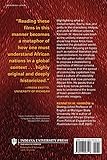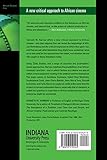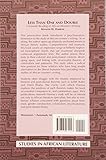In his new book Trash: African Cinema from Below, Kenneth W. Harrow examines trash as a notion that allows him to assume a valuable epistemological perspective – one from below. Harrow is interested in articulating the subversive potential of the discarded, claiming that the aesthetics of trash – which he seeks to locate in the archive of postcolonial African cinema – is “key to the material dimensions of society and culture.”
A scene from Mooladé by director Ousmane Sembene, 2004.
The location of trash – “below” – is a stand-in for the Global South, a vast region that often figures in the global imagination as the endpoint of consumption and as the place for human detritus – the people rendered useless by the global market economy. Instead of refuting this vision as an expression of colonial desire, Harrow seeks to explore the epistemological advantage the location at the garbage dump offers. The view from the endpoint of the global consumption chain allows deeper insights into how social wealth is created and distributed, offering “a critical vantage point from which to see society as a whole.”
If the search for images of waste in African cinema sounds grim and the equation of the Global South with the garbage dump sounds deeply pessimistic, it is. The book revels in scenes of abjection as the author sorts through narratives of misery and despair abundant in the African postcolonial imaginary. The reader should be prepared to encounter close-up images of things that are broken, systems that have failed, and bodies that have lost their capacity for work. Above all, the book abounds in images of “redundant” people. We encounter dark, unforgettable depictions of violence that cannot be comprehended, let alone redeemed. We learn the stories of emigrants that die en route to the Global North, their bodies left to decompose in the desert; observe street children who brag about their missing limbs and the pain they have managed to endure; and encounter victims of genocide, numb and shell-shocked, as they return back to their homelands.
Harrow’s archive is imposing: the book’s filmography contains over ninety films produced in various African countries between 1968 and 2011. The list of represented countries is impressive and includes Ghana, Nigeria, Cameroon, Rwanda, Chad, Zimbabwe, Mauritania, Mali, Algeria, Angola, and Ethiopia, among others. The majority are auteur feature films, with some documentaries, and a few examples of popular Nollywood cinema. The importance of the book thus lies in its scope, making it appealing to readers interested in non-Western cinema.
The trajectory of the book is mostly downward; the examples get progressively more macabre, culminating in the analysis of Fanta Nacro’s feature film La nuit de la veritè (2004), where the degradation of human bodies reaches its limits with the images of limbs and other body fragments floating in the stream among other debris and the phantasmagoria of an officer’s body being marinated and roasted on a spit by a delirious matriarch who seeks revenge for the death of her son. The last chapters are lighter in tone and offer some relief from the images of lawless violence and despair as Harrow turns to his analysis of Nollywood cinema – the mass-produced cinema of Nigeria.
On the theoretical side, the author enters into a dialogue with some of his precursors – Douglas, Kristeva, Culler, and Stan – and their ideas regarding waste and pollution. Harrow resists the temptation to view trash as holding the potential for regeneration – such as recycling and art – or seeing trash as abject whose role is to maintain and uphold the boundary between subject and object. Instead, the author proposes a more radical vision of trash as something that resists recuperation; it is imagined as a signifier of objects utterly devoid of value, objects that are broken beyond repair and cannot be restored or recycled back into the market economy. Initially locating the site of trash as “below,” Harrow then argues against the very hierarchy of high and low, proposing that trash serves to destabilize the given order of things by being out of place – effectively polluting and disrupting the hierarchies of power and domination. In its radical inability to assimilate, trash comes to signify the radical outside of a socio-political system – the outcasts who cannot be represented and who do not factor into the status quo.
Harrow uses the distinction between the ochlos (the exclusionary community) and the demos (the community of the excluded) developed by Rancière. In Harrow’s account, trash becomes representative of the demos – those who are rendered useless by the market economy, rendered invisible by the dominant system of representation. Subsequently, Harrow links the notion of trash or detritus to Rancière’s concept of dissensus – a disruption of the system of representation/representability caused by those who are excluded from this system. Rather than being a struggle of the dispossessed against their oppressors, dissensus is a revolution in the sensory experience created through images, a revolution of the aesthetic regime.
Such revolution occurs through the presence of uncomfortable images – “images we can’t stand, were never meant to stand.” But what are the images that the spectator cannot bear? Harrow calls such images “naked images,” once again borrowing the concept from Rancière who distinguished such images from “ostensive” and “metamorphic” images. Naked images are evocative of Agamben’s concept of “bare life” (zoe) as opposed to political, or properly human life (bios). A naked image communicates something about the mere “is” of bare life in the state of exception, where all its value associated with bios is lost. Such raw images – naked images – cannot be subject to interpretation, are obscene, being an imprint of the thing itself. What we see in a naked image, what becomes visible, is not “sayable.” A naked image maintains certain immediacy to its object, holding the spectator’s gaze. It adheres to the logic of equivalence (tautology) – “this is this is this.” The naked image is thus always more than just an image.
A scene from Daratt by director Mahamat Saleh Haroun, 2006.
A scene from Karmen Geï by director Joseph Gaï Ramaka, 2001.
The part of the book devoted to developing a theory of trash (garbology) seems unnecessarily long, however. Some of the book’s most powerful moments are found in sections that offer close readings of specific films. An impatient reader might be better served by skipping the introductory chapters altogether and focusing on the film analyses instead. In the chapters on La Nuit, Trouble the Water, Bamako, and Daratt, Harrow offers a poignant and detailed reading of bodies reduced to waste, of bodies involved in the arduous labor of self-preservation by focusing on frames that feature “naked images” where bare life can be seen. In a fashion reminiscent of Laura Mulvey’s analysis of fetishism in “Visual Pleasure and Narrative Cinema,” Harrow talks about the freezing of the narrative in the naked image. The spectator is captivated by the naked image – such images do not circulate diegetically but stop all circulation and are meta-diegetic or hypo-diegetic. In their immediacy, naked images can appear apolitical when in fact they are ultra-political, articulating a different kind of politics – the politics of dissensus.
Some applications of Harrow’s theory of trash are more convincing than others. For instance, his close readings of Nacro’s La nuit de la veritè and Sissako’s Bamako (2006) are captivating, but the concept of trash seems to have taken the backseat giving way to the concept of bare life as seen in the naked image. Similarly, his analysis of the breakdown of patriarchy that he traces in films such as Karmen Gei (2001), Puk Nini (1995), and Nollywood’s Osuofia in London (2004) is inspired, but the connection to trash is only tangential, despite insistently calling the women in these films “trashy women.”
Ultimately, however, Harrow’s project accomplishes what it set out to do. Faithful to his claim that trash disturbs the hierarchies of high and low, Harrow pays attention to African cinema in its various forms: from politically charged auteur cinema to Nollywood – “the most studiously apolitical of African cinemas.” The discussion of Nollywood, with its depictions of urban glitter, excess, and overconsumption, provides a necessary counterpart to the analysis of images of detritus in auteur films, thus exposing the paradoxes of commodity and waste as they figure in the robust archive of postcolonial African cinema.
Alla Ivanchikova is an assistant professor in the Department of English and Comparative Literature at Hobart and William Smith Colleges. She specializes in contemporary global Anglophone literatures and critical theory.



